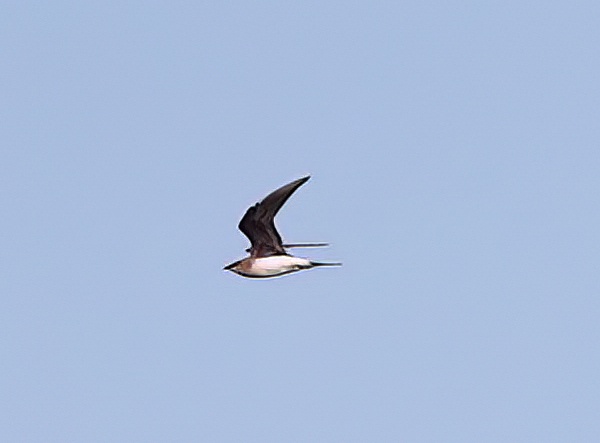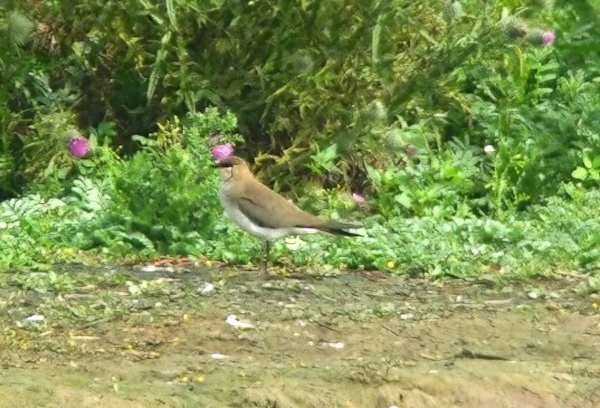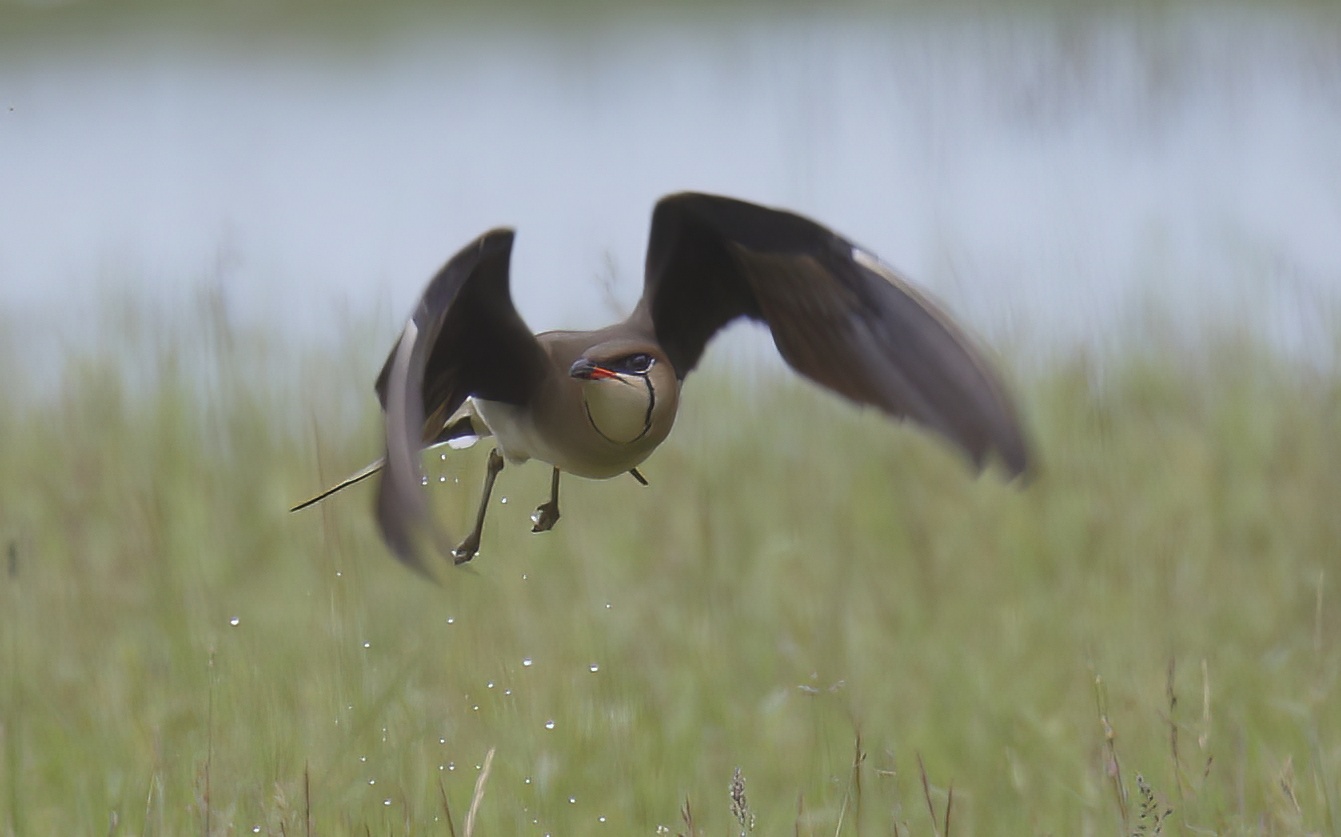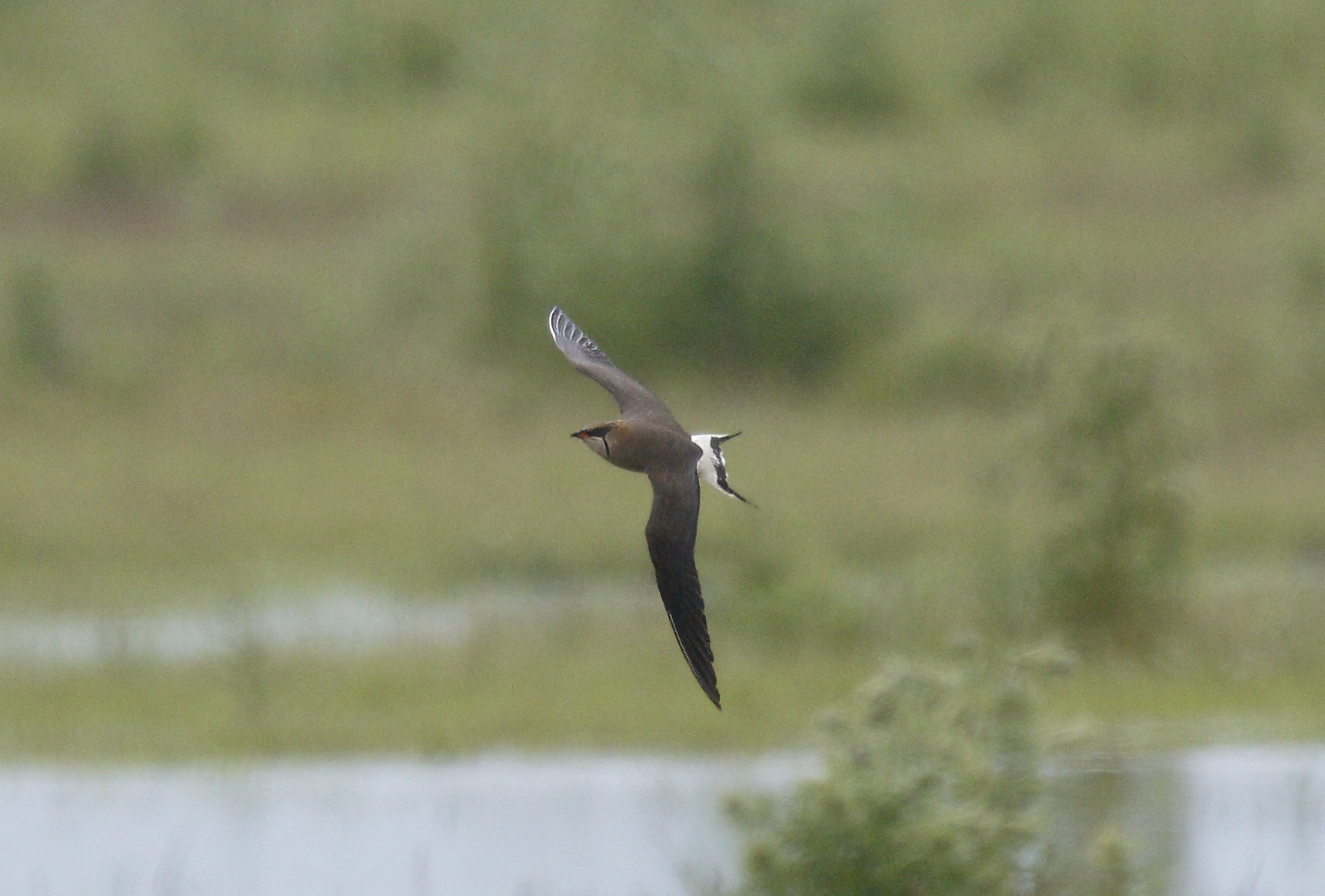Black-winged Pratincole Glareola nordmanni
Vagrant. South-east Europe through Ukraine to SW Russia and N Kazakhstan.




Above, two photographs of the Black-winged Pratincole at Frampton Marsh June 19th 2019, courtesy of Steve Gantlett.
Two modern records of this Pratincole in July 2014 and June 2019, the latter completing a very nice hat-trick for Frampton Marsh after Collared Pratincole, G. pratincola, in 2009 and Oriental Pratincole, G. maldivarum in 2010. The first record at Gibraltar Point dropped into Tennyson’s Marsh early morning and proved to be an immaculate adult, an excellent find. It showed well for a fortunate small band of observers before disappearing off to the south a few hours after it was first found. The BBRC report on rare birds in 2014 reports that there were records from seven recording areas between Sussex and Northumberland but given that Pratincoles have a track record of ranging widely it was assumed that these referred to just one individual. This bird disappointed many, so a repeat at Frampton Marsh in June 2019 was more than welcome, especially as it stayed for four days in all; this was the 38th British record at the time and there have now been 39 British records, 1950-2020.
European breeders are confined to the northern Black Sea in Romania and Ukraine where they are rare and declining. To the east, they are more numerous across the steppes of S Russia to E Kazakhstan. In Britain, they remain a major rarity turning up every 1-2 years.
| Site | First date | Last date | Count | Notes |
| Gibraltar Point | 14/07/2014 | 1 | Adult | |
| Frampton Marsh | 18/06/2019 | 21/06/2019 | 1 | Adult |
Finder's report: Black-winged Pratincole Glareola nordmanni at Gibraltar Point, 14th July 2014, first county record.
by J. P. Shaughnessy.
Note: this account is taken from the original submission to BBRC. The record was accepted (British Birds 108(10): 565-633) and there were seven records from other recording areas in 2014 between Cleveland and Sussex, and all were regarded as referring to the same individual.
I had been at Gibraltar Point NNR since Sunday 6th July, and apart from one rainy day, and was out birdwatching from very early morning to dusk every day. Really early starts became more difficult as the days passed, and on Monday 14th July I was slightly later than usual. After a quick cup of tea in the Sykes Farm reserve office, and a short chat with Nige Lound who was processing his moth-trap catch, I set off for the morning at 0650hrs. However, feeling that it might be a bit chilly, I turned back to my car to get a jacket. I had got the door open and was rummaging around when something made me look back over my shoulder, eastward towards the buildings.
A single bird was in a shallow descending glide 50m away just beyond the office building, about 25 m up and heading northward towards the freshwater areas of Jackson's Marsh and Tennyson's Sands. Instantly thinking pratincole or unusual tern, I dropped everything and managed a two or three second view through binoculars before the bird passed out of view. Although cloudy, it was reasonably bright, so looking eastwards just gave little more than a silhouette, however I was certain of dark upper-parts and a tightly closed longish tail tapering to a fine point; also, I hadn't seen any bill to speak of. I shouted "pratincole, probably" to Nige as I dashed to and up the fire escape steps on the north side of the office building; however, on quickly scanning towards the water bodies there was no sign of it.
Taking a guess that Tennyson's Sands was the best bet for finding the bird I grabbed my 'scope, left Nige to the moths and ran to Harvey's Hide at the south end of Tennyson Sands. On the way, I gave site manager Kev Wilson a call, but I knew he was distantly away in the shorebird sanctuary with Richard Doan looking after tern and wader nests on the rising tide. Anyway, neither answered, the sound of the sea drowning the ring tones apparently. Quickly into the hide, I started searching the areas favoured by waders and immediately found what I was looking for. The pratincole, a smart adult in breeding plumage, was stood motionless in the open, 90 m away (measured on aerial photograph) amongst a scatter of Lapwing, Black-tailed Godwit, Redshank, Black-headed Gull, Teal and other waterbirds.
Although I was aware of the Black-winged Pratincole which had been in northeast England, I was not going to let that influence the identification, so I just set myself to stare at the bird until it showed conclusive features. At the same time, I phoned Nige, who said he would be there in 10min. after he had finished the moths, and R. K. Watson, and Kev, who had noticed his missed call and phoned me a couple of minutes earlier. Initial views, though in now dull conditions, certainly indicated Black-winged rather than Collared Pratincole. I had more or less dismissed Oriental on the basis of tail length as the bird passed over Sykes Farm. Now, from the hide, I could see that there was only a very small amount of darkish red at the base of the lower mandible and into the gape, and that the loral area was very dark. The back was a mid-brown, the scapulars area below slightly darker, and the coverts darker brown still, showing little contrast with the blackish visible primaries. Even the mid or dark grey legs looked long, though that was mainly when the bird was alert. The tail was longer than I expected for Black-winged, being equal to the primary tips when the bird was in a relaxed posture. Both tail and primaries looked undamaged and not particularly worn. Unfortunately, the tail was mostly held tightly closed, so I never got a good view of its structure or exact colour pattern; I had a glimpse of a tail fork just once.
Additionally, of course, I had noted the general plumage of the bird, including the pale creamy buff throat and upper breast area enclosed by a sharply defined thin black line which reached up to below the eye. Below the black line was a rather pale brownish breast which quickly faded into the pure white underparts, these reaching to the tail, and wrapping round to give a large white rump/upper-tail area, the tail itself appearing black. The pale brownish of the breast darkened upwards to the sides of the neck and the nape, these latter then appearing slightly paler than the back. The forehead to crown was a slightly darker brown than the rest of the head. Light and angle of viewing did change the subtle shades of these brown areas though.
Whilst waiting for others to arrive I kept my eye firmly to my 'scope, not wanting to miss a wing stretch or flight. The bird did run around a little, and was edged out of the way a few times by Black-headed Gulls but did nothing to give a conclusive view. One brief wing flick confirmed the darkness of the wing-coverts and low contrast with the primaries and primary coverts but failed to show the trailing edge. Nige soon arrived, Rob Watson a little later, and so we settled down to watch and wait, now in improved light with the sun coming out. Another brief wing opening gave a fleeting view of the secondaries, and I was just about convinced of lack of any white tips but needed a better view. So, when Kev arrived, we just said "yes, it's a Black-winged, but we still need to see the trailing edge and underwing". Another 20 minutes or so passed, the four of us staring hard, then the bird took sudden flight for no apparent reason, and luckily took a line low right across in front of us, about 60 m away. I had the bird in my 'scope view as it took off and was able to follow it in flight, clearly seeing the completely blackish secondaries, and the black underwing. On the latter, I could discern some individual feather structure in the basal area and axillaries, so was certain of the colour, including a very slight slaty tint, and certain that I was not just seeing a deeply shaded area.
We all said "Black-winged" in satisfaction, then exited the hide to watch the bird gain height southward back over Sykes Farm. However, it soon veered more south-eastwards, then began to lose height towards the shore and Wash saltmarsh and was quickly out of sight. Kev and Nige departed, but Rob and I returned to the hide in case of a return. After maybe 15 minutes or so of idle chatter, Rob gave a hesitant and questioning "Green Sandpiper dropping in?", quickly followed by "it's back, the pratincole". It was back to the same spot it had left.
Birders from further afield began to arrive, and the hide was soon full. The pratincole was a little more active, but the few low short flights it made around islands in the lagoon never gave a good view of critical features; also, it was out of view for a while, or a little more distant. It was only at about 10.10 hrs, when it took off again, that many in the hide felt totally satisfied with the identification, the bird showing upper and underwing well. An explosion of bleeps and clicks accompanied the retracing of its previous flight, but this time it continued southward, slowly gaining height and was soon lost to view in a bright sky. Unfortunately, several birders were still running towards the hide as it departed, and either missed it completely, or saw a disappearing dot.
One point worth mentioning is that when I first saw the bird pass over Sykes Farm, I got the distinct impression that it knew exactly where it was going. The line of its glide, and angle of descent, were aimed right at the spot where I found it minutes later. Newly arrived birds tend to fly around and explore the site before deciding whether to land or not. I suspect that the pratincole had been to Tennyson's Sands earlier.
(Account as per new Birds of Lincolnshire (2021), included September 2022)

